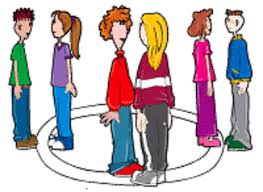Student Contributor: T. Prestegord
 Gives the students the opportunity to share with their peers and talk about different topics. It is also nice because you can switch partners by just turning around.
Gives the students the opportunity to share with their peers and talk about different topics. It is also nice because you can switch partners by just turning around.
For this tool, have the students get into a circle. After they have circled up have them count off in two’s. Once they have all counted off, this is when you will choose one number to turn around and talk to the opposite numbered person/ partner. At this point you can give them a question and or topic to talk about for a couple of minutes. Following the end of the time period, you can have the opposite partner turn around and then they can continue deeper into the conversation and or explore another question. This gives the students the possibility to get out of their seats and talk with peers.
 Its the supportive phase because it gives students the opportunity to work with other students and build connections with them. When students have connections with their peers it gives them the opportunity to feel connected to them making them feel safer. This could also be used for the preventative stage giving them the opportunity to talk about how they feel and how they may want to be treated or want to treat others. I think that this goes well with the collaborative phase because it gives the students the opportunity to give and take with the teacher. This gives both the opportunity for student voice and teachers voice to be heard over different topics.
Its the supportive phase because it gives students the opportunity to work with other students and build connections with them. When students have connections with their peers it gives them the opportunity to feel connected to them making them feel safer. This could also be used for the preventative stage giving them the opportunity to talk about how they feel and how they may want to be treated or want to treat others. I think that this goes well with the collaborative phase because it gives the students the opportunity to give and take with the teacher. This gives both the opportunity for student voice and teachers voice to be heard over different topics.
More Information –
Tool Source: Gus in class



Supportive: Circle up
(5th graders, 25 students, title one school)
This tool was fun to prepare for teaching and use. It did have its hurdles because students at first were excited to be standing up and needed a bit of redirection to stay on task and remember our new expectations. The success I found with this tool was an increased amount of engagement into the discussions. The students at first needed some additional support understanding of their role, but after they caught on they understood their place in the exercise very well. One tip I have to improve this tool to make it better is to ensure you take time to build up a strong community with respect to expectations first and explicitly express your expectations for this activity. All in all this tool made day to day discussion and turn and talks with small groups more engaging for everyone involved, and in general was a fun experience!